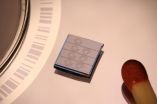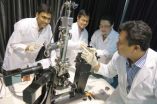(Press-News.org) This news release is available in German.
Miniaturized optical frequency comb sources allow for transmission of data streams of several terabits per second over hundreds of kilometers – this has now been demonstrated by researchers of Karlsruhe Institute of Technology (KIT) and the Swiss École Polytechnique Fédérale de Lausanne (EPFL) in a experiment presented in the journal Nature Photonics. The results may contribute to accelerating data transmission in large computing centers and worldwide communication networks. (DOI: 10.1038/NPHOTON.2014.57.)
The amount of data generated and transmitted worldwide is growing continuously. With the help of light, data can be transmitted rapidly and efficiently. Optical communication is based on glass fibers, through which optical signals can be transmitted over large distances with hardly any losses. So-called wavelength division multiplexing (WDM) techniques allow for the transmission of several data channels independently of each other on a single optical fiber, thereby enabling extremely high data rates. For this purpose, the information is encoded on laser light of different wavelengths, i.e. different colors. However, scalability of such systems is limited, as presently an individual laser is required for each transmission channel. In addition, it is difficult to stabilize the wavelengths of these lasers, which requires additional spectral guard bands between the data channels to prevent crosstalk.
In the study presented in "Nature Photonics", the scientists of KIT, together with their EPFL colleagues, applied a miniaturized frequency comb as optical source. They reached a data rate of 1.44 terabits per second and the data was transmitted over a distance of 300 km. This corresponds to a data volume of more than 100 million telephone calls or up to 500 000 high-definition (HD) videos. For the first time, the study shows that miniaturized optical frequency comb sources are suited for coherent data transmission in the terabit range.
Optical frequency combs, for the development of which John Hall and Theodor W. Hänsch received the 2005 Nobel Prize in Physics, consist of many densely spaced spectral lines, the distances of which are identical and exactly known. So far, frequency combs have been used mainly for highly precise optical atomic clocks or optical rulers measuring optical frequencies with utmost precision. However, conventional frequency comb sources are bulky and costly devices and hence not very well suited for use in data transmission. Moreover, spacing of the spectral lines in conventional frequency combs often is too small and does not correspond to the channel spacing used in optical communications, which is typically larger than 20 GHz.
In their joint experiment, the researchers of KIT and the EPFL have now demonstrated that integrated optical frequency comb sources with large line spacings can be realized on photonic chips and applied for the transmission of large data volumes. For this purpose, they use an optical microresonator made of silicon nitride, into which laser light is coupled via a waveguide and stored for a long time. "Due to the high light intensity in the resonator, the so-called Kerr effect can be exploited to produce a multitude of spectral lines from a single continuous-wave laser beam, hence forming a frequency comb," explains Jörg Pfeifle, who performed the transmission experiment at KIT. This method to generate these so-called Kerr frequency combs was discovered by Tobias Kippenberg, EPFL, in 2007. Kerr combs are characterized by a large optical bandwidth and can feature line spacings that perfectly meet the requirements of data transmission. The underlying microresonators are produced with the help of complex nanofabrication methods by the EPFL Center of Micronanotechnology. "We are among the few university research groups that are able to produce such samples," comments Kippenberg. Work at EPFL was funded by the Swiss program "NCCR Nanotera" and the European Space Agency ESA.
Scientists of KIT's Institute of Photonics and Quantum Electronics (IPQ) and Institute of Microstructure Technology (IMT) are the first to use such Kerr frequency combs for high-speed data transmission. "The use of Kerr combs might revolutionize communication within data centers, where highly compact transmission systems of high capacity are required most urgently," Christian Koos says. He coordinates the work under a Starting Independent Researcher Grant funded by the European Research Council (ERC). "We are just at the beginning. In the experiment presented, we only use 20 lines of the frequency comb. This may certainly be increased. New experiments are planned." Work at KIT is supported by the Alfried Krupp von Bohlen and Halbach Foundation.
INFORMATION:
Joerg Pfeifle, Victor Brasch, Matthias Lauermann, Yimin Yu, Daniel Wegner, Tobias Herr, Klaus Hartinger, Philipp Schindler, Jingshi Li, David Hillerkuss, Rene Schmogrow, Claudius Weimann, Ronald Holzwarth, Wolfgang Freude, Juerg Leuthold, Tobias J. Kippenberg, Christian Koos: Coherent terabit communications with microresonator Kerr frequency combs. Nature Photonics (2014). DOI: 10.1038/NPHOTON.2014.57.
Karlsruhe Institute of Technology (KIT) is a public corporation according to the legislation of the state of Baden-Württemberg. It fulfills the mission of a university and the mission of a national research center of the Helmholtz Association. Research activities focus on energy, the natural and built environment as well as on society and technology and cover the whole range extending from fundamental aspects to application. With about 9000 employees, including nearly 6000 staff members in the science and education sector, and 24000 students, KIT is one of the biggest research and education institutions in Europe. Work of KIT is based on the knowledge triangle of research, teaching, and innovation.
The Ècole Polytechnique Fédéral de Lausanne (EPFL) is a technical university in Switzerland situated in the Canton Vaud, at the shore of the picturesque Lake Geneva. Together with the ETH Zurich the EPFL constitutes the ETH Domain of swiss national technical universities. EPFL is Europe's most cosmopolitan technical university. It receives students, professors and staff from over 120 nationalities. With both a Swiss and international calling, it is therefore guided by a constant wish to open up; its missions of teaching, research and partnership impact various circles: universities and engineering schools, developing and emerging countries, secondary schools and gymnasiums, industry and economy, political circles and the general public.
This press release is available on the internet at http://www.kit.edu.
The photo of printing quality may be downloaded under http://www.kit.edu or requested by mail to presse@kit.edu or phone +49 721 608-4 7414.
The photo may be used in the context given above exclusively.
Combs of light accelerate communication
2014-04-14
ELSE PRESS RELEASES FROM THIS DATE:
Proteomics International biomarker study closer to a CDx test for diabetic kidney disease
2014-04-14
April 2014, Perth, Australia. Drug discovery company Proteomics International has completed an important milestone towards the development of a companion diagnostic (CDx) test with the validation of several of its protein biomarkers.
The research team authenticated the panel of biomarkers after taking 508 highly curated disease and control samples. Seven biomarkers were validated at high stringency using the company's proprietary mass spectrometry approach.
The mass spectrometry data was then cross-validated using immunoassays in collaboration with the KTH Royal Institute ...
Beneficial organisms react differently to parasite drug
2014-04-14
The substance ivermectin has been used for more than thirty years all over the world to combat parasites like roundworms, lice and mites in humans, livestock and pets. The active ingredient belongs to the chemical group of avermectins, which generally disrupt cell transport and thus attack pests. When ivermectin is excreted in the faeces of treated animals, at overly high doses it also harms dung-degrading beneficial insects like dung beetles and dung flies. This impairs the functioning of the ecosystem. In extreme cases the dung is not decomposed and the pasture is destroyed.
Sensitivity ...
Does germ plasm accelerate evolution?
2014-04-14
Scientists at The University of Nottingham have published research in the leading academic journal Science that challenges a long held belief about the way certain species of vertebrates evolved.
Dr Matt Loose and Dr Andrew Johnson who are experts in genetics and cell development in the School of Life Sciences carried out the research, funded by the Medical Research Council (MRC). It suggests that genes evolve more rapidly in species containing germ plasm. The results came about as they put to the test a novel theory that early developmental events dramatically alter ...
Novel technique developed by NUS scientists opens door to better solar cells
2014-04-14
A team of scientists, led by Assistant Professor Andrivo Rusydi from the Department of Physics at the National University of Singapore's (NUS) Faculty of Science, has successfully developed a technique to study the interface between materials, shedding light on the new properties that arise when two materials are put together.
With a better understanding of how materials interface, scientists can tweak the properties of different materials more easily, and this opens doors to the development of better solar cells, novel superconductors and smaller hard drives.
The ...
Stanford team develops single cell genomics technique to reverse engineer developing lung
2014-04-14
Consider the marvel of the embryo. It begins as a glob of identical cells that change shape and function as they multiply to become the cells of our lungs, muscles, nerves and all the other specialized tissues of the body.
Now, in a feat of reverse tissue engineering, Stanford researchers have begun to unravel the complex genetic coding that allows embryonic cells to proliferate and transform into all of the specialized cells that perform a myriad of different biological tasks.
A team of interdisciplinary researchers took lung cells from the embryos of mice, choosing ...
Saturn's hexagon: An amazing phenomenon
2014-04-14
In 1980 and 1981 NASA's Voyager 1 and 2 space probes passed for the first time over the planet Saturn, located 1,500 million km from the Sun. Among their numerous discoveries they observed a strange, hexagon-shaped structure in the planet's uppermost clouds surrounding its north pole. The hexagon remained virtually static, without moving, vis-à-vis the planet's overall rotation that was not accurately known. What is more, the images captured by the Voyager probes found that the clouds were moving rapidly inside the hexagon in an enclosed jet stream and were being dragged ...
Longer nurse tenure on hospital units leads to higher quality care
2014-04-14
(NEW YORK, NY, April 14, 2014) – When it comes to the cost and quality of hospital care, nurse tenure and teamwork matters. Patients get the best care when they are treated in units that are staffed by nurses who have extensive experience in their current job, according to a study from researchers at Columbia University School of Nursing and Columbia Business School. The study was published in the current issue of the American Economics Journal: Applied Economics.
The review of more than 900,000 patient admissions over four years at hospitals in the Veterans Administration ...
Chemotherapy before or after surgery for high-risk bladder cancer improves survival, but is not routinely administered
2014-04-14
Contrary to treatment guidelines for high-risk bladder cancer, chemotherapy before or after surgery is not commonly used in routine clinical practice. The findings are published early online in Cancer, a peer-reviewed journal of the American Cancer Society.
Clinical trials have shown that survival is improved in patients with muscle-invasive bladder cancer who are given chemotherapy before surgery. There is less evidence about whether chemotherapy after surgery also improves survival. To investigate the use of peri-operative chemotherapy in this disease, Christopher Booth, ...
Celebrity Hairstylist Fateemah Lends Her Talents to "I Am Everything" Benefit Fashion Show
2014-04-14
Award-winning style maven Faatemah has signed on as lead hairstylist for designer Emma Berg's "I Am Everything" benefit fashion event, Tuesday, April 22 at the Ritz Theater. Combining the worlds of fashion and philanthropy, the event will feature Berg's Spring/Summer 2014 collection of prom dresses inspired by 10 senior high school students selected from five Boys & Girls Clubs across the Twin Cities. The young women will walk the runway in the dresses designed exclusively for them.
Faatemah will provide hair styling services and direction, bringing her retro glam ...
Author and Poet Kneika Robbins Shares Her Writing Journey via the Dark Mantis Talk Show
2014-04-14
Kneika Robbins is a gifted motivational writer that enjoys the art of writing and sharing her poetry with the world. Kneika has been writing for 23 years. Kneika is now a motivational poetry columnist for Sibella Poetry Magazine and involved with the program "Poet a Day" at Johnson County Library. Kneika will also discuss her first novel titled "Serious Thoughts" with Jeanette Michelle.
Kneika Robbins is a wife and mother who are an Educator, Assessor and Mentor when she is not writing. Kneika earned her Bachelor's degree in Healthcare Administration and Associates ...




